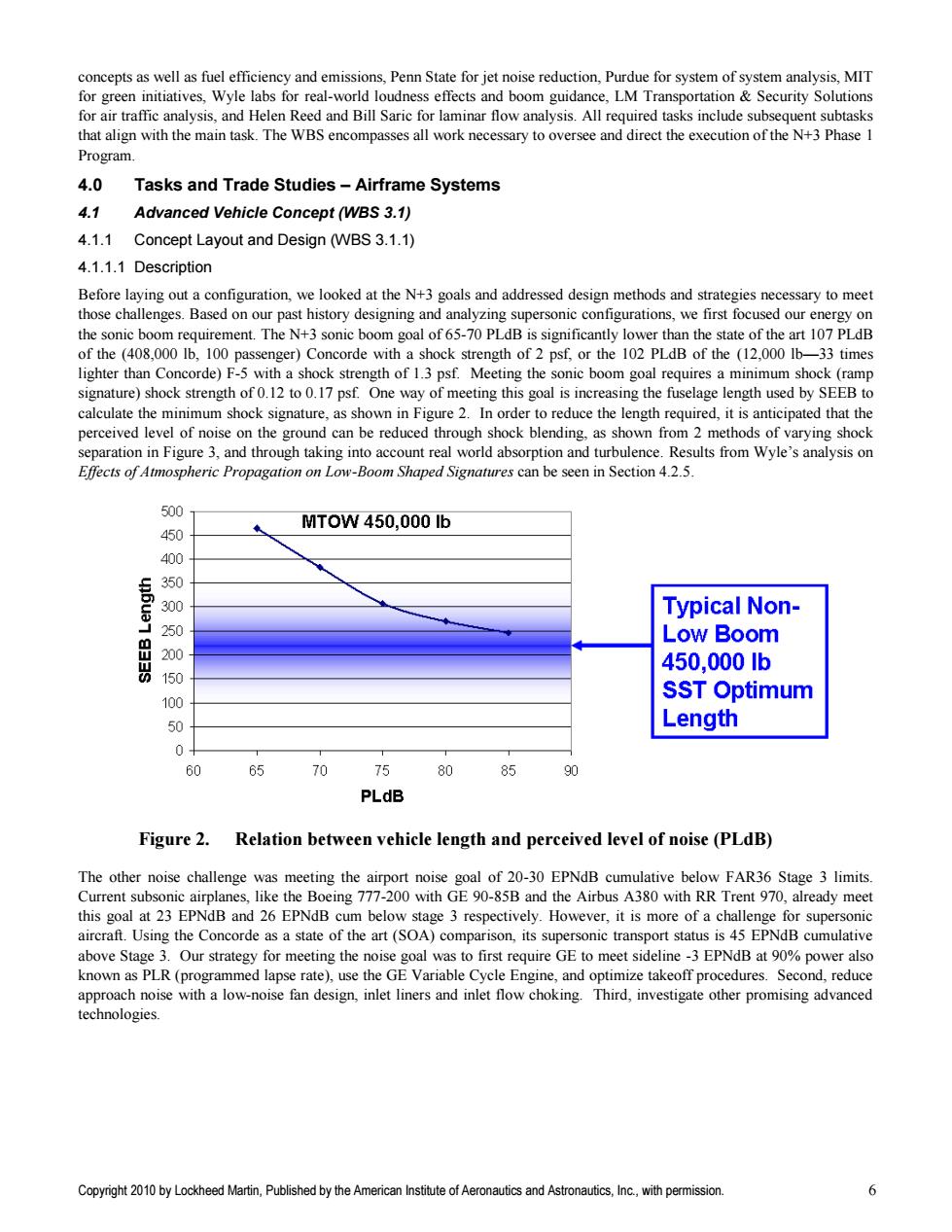正在加载图片...

concepts as well as fuel efficiency and emissions,Penn State for jet noise reduction,Purdue for system of system analysis,MIT for green initiatives,Wyle labs for real-world loudness effects and boom guidance,LM Transportation Security Solutions for air traffic analysis,and Helen Reed and Bill Saric for laminar flow analysis.All required tasks include subsequent subtasks that align with the main task.The WBS encompasses all work necessary to oversee and direct the execution of the N+3 Phase 1 Program. 4.0 Tasks and Trade Studies-Airframe Systems 4.1 Advanced Vehicle Concept(WBS 3.1) 4.1.1 Concept Layout and Design (WBS 3.1.1) 4.1.1.1 Description Before laying out a configuration,we looked at the N+3 goals and addressed design methods and strategies necessary to meet those challenges.Based on our past history designing and analyzing supersonic configurations,we first focused our energy on the sonic boom requirement.The N+3 sonic boom goal of 65-70 PLdB is significantly lower than the state of the art 107 PLdB of the (408,000 Ib,100 passenger)Concorde with a shock strength of 2 psf,or the 102 PLdB of the (12,000 Ib-33 times lighter than Concorde)F-5 with a shock strength of 1.3 psf.Meeting the sonic boom goal requires a minimum shock(ramp signature)shock strength of 0.12 to 0.17 psf.One way of meeting this goal is increasing the fuselage length used by SEEB to calculate the minimum shock signature,as shown in Figure 2.In order to reduce the length required,it is anticipated that the perceived level of noise on the ground can be reduced through shock blending,as shown from 2 methods of varying shock separation in Figure 3,and through taking into account real world absorption and turbulence.Results from Wyle's analysis on Effects of Atmospheric Propagation on Low-Boom Shaped Signatures can be seen in Section 4.2.5. 500 MTOW 450,000 Ib 450 400 350 300 Typical Non- 250 Low Boom 200 450,000Ib 150 100 SST Optimum 50 Length 0 60 65 70 75 80 85 90 PLdB Figure 2. Relation between vehicle length and perceived level of noise (PLdB) The other noise challenge was meeting the airport noise goal of 20-30 EPNdB cumulative below FAR36 Stage 3 limits. Current subsonic airplanes,like the Boeing 777-200 with GE 90-85B and the Airbus A380 with RR Trent 970,already meet this goal at 23 EPNdB and 26 EPNdB cum below stage 3 respectively.However,it is more of a challenge for supersonic aircraft.Using the Concorde as a state of the art(SOA)comparison,its supersonic transport status is 45 EPNdB cumulative above Stage 3.Our strategy for meeting the noise goal was to first require GE to meet sideline-3 EPNdB at 90%power also known as PLR(programmed lapse rate),use the GE Variable Cycle Engine,and optimize takeoff procedures.Second,reduce approach noise with a low-noise fan design,inlet liners and inlet flow choking.Third,investigate other promising advanced technologies. Copyright 2010 by Lockheed Martin,Published by the American Institute of Aeronautics and Astronautics,Inc.,with permission. 6Copyright 2010 by Lockheed Martin, Published by the American Institute of Aeronautics and Astronautics, Inc., with permission. 6 concepts as well as fuel efficiency and emissions, Penn State for jet noise reduction, Purdue for system of system analysis, MIT for green initiatives, Wyle labs for real-world loudness effects and boom guidance, LM Transportation & Security Solutions for air traffic analysis, and Helen Reed and Bill Saric for laminar flow analysis. All required tasks include subsequent subtasks that align with the main task. The WBS encompasses all work necessary to oversee and direct the execution of the N+3 Phase 1 Program. 4.0 Tasks and Trade Studies – Airframe Systems 4.1 Advanced Vehicle Concept (WBS 3.1) 4.1.1 Concept Layout and Design (WBS 3.1.1) 4.1.1.1 Description Before laying out a configuration, we looked at the N+3 goals and addressed design methods and strategies necessary to meet those challenges. Based on our past history designing and analyzing supersonic configurations, we first focused our energy on the sonic boom requirement. The N+3 sonic boom goal of 65-70 PLdB is significantly lower than the state of the art 107 PLdB of the (408,000 lb, 100 passenger) Concorde with a shock strength of 2 psf, or the 102 PLdB of the (12,000 lb—33 times lighter than Concorde) F-5 with a shock strength of 1.3 psf. Meeting the sonic boom goal requires a minimum shock (ramp signature) shock strength of 0.12 to 0.17 psf. One way of meeting this goal is increasing the fuselage length used by SEEB to calculate the minimum shock signature, as shown in Figure 2. In order to reduce the length required, it is anticipated that the perceived level of noise on the ground can be reduced through shock blending, as shown from 2 methods of varying shock separation in Figure 3, and through taking into account real world absorption and turbulence. Results from Wyle‘s analysis on Effects of Atmospheric Propagation on Low-Boom Shaped Signatures can be seen in Section 4.2.5. Figure 2. Relation between vehicle length and perceived level of noise (PLdB) The other noise challenge was meeting the airport noise goal of 20-30 EPNdB cumulative below FAR36 Stage 3 limits. Current subsonic airplanes, like the Boeing 777-200 with GE 90-85B and the Airbus A380 with RR Trent 970, already meet this goal at 23 EPNdB and 26 EPNdB cum below stage 3 respectively. However, it is more of a challenge for supersonic aircraft. Using the Concorde as a state of the art (SOA) comparison, its supersonic transport status is 45 EPNdB cumulative above Stage 3. Our strategy for meeting the noise goal was to first require GE to meet sideline -3 EPNdB at 90% power also known as PLR (programmed lapse rate), use the GE Variable Cycle Engine, and optimize takeoff procedures. Second, reduce approach noise with a low-noise fan design, inlet liners and inlet flow choking. Third, investigate other promising advanced technologies